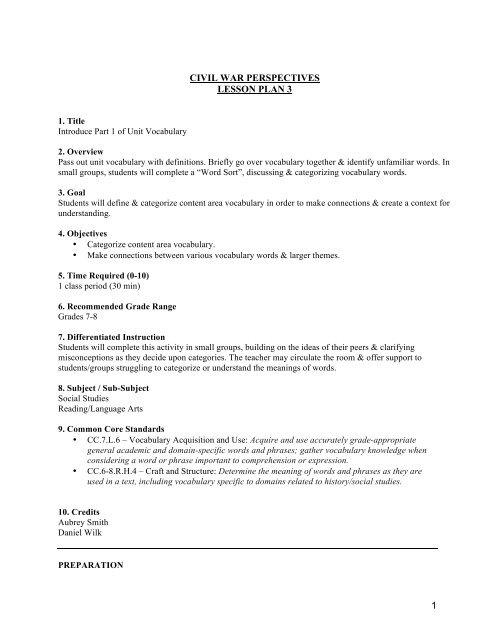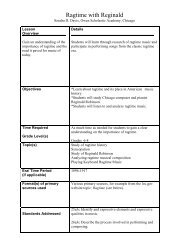1 civil war perspectives lesson plan 3 - Loyola University Chicago
1 civil war perspectives lesson plan 3 - Loyola University Chicago
1 civil war perspectives lesson plan 3 - Loyola University Chicago
- No tags were found...
Create successful ePaper yourself
Turn your PDF publications into a flip-book with our unique Google optimized e-Paper software.
CIVIL WAR PERSPECTIVESLESSON PLAN 31. TitleIntroduce Part 1 of Unit Vocabulary2. OverviewPass out unit vocabulary with definitions. Briefly go over vocabulary together & identify unfamiliar words. Insmall groups, students will complete a “Word Sort”, discussing & categorizing vocabulary words.3. GoalStudents will define & categorize content area vocabulary in order to make connections & create a context forunderstanding.4. Objectives• Categorize content area vocabulary.• Make connections between various vocabulary words & larger themes.5. Time Required (0-10)1 class period (30 min)6. Recommended Grade RangeGrades 7-87. Differentiated InstructionStudents will complete this activity in small groups, building on the ideas of their peers & clarifyingmisconceptions as they decide upon categories. The teacher may circulate the room & offer support tostudents/groups struggling to categorize or understand the meanings of words.8. Subject / Sub-SubjectSocial StudiesReading/Language Arts9. Common Core Standards• CC.7.L.6 – Vocabulary Acquisition and Use: Acquire and use accurately grade-appropriategeneral academic and domain-specific words and phrases; gather vocabulary knowledge whenconsidering a word or phrase important to comprehension or expression.• CC.6-8.R.H.4 – Craft and Structure: Determine the meaning of words and phrases as they areused in a text, including vocabulary specific to domains related to history/social studies.10. CreditsAubrey SmithDaniel WilkPREPARATION1
11. Materials UsedCivil War Unit Vocabulary List (Part 1) – 2 sidedWord Sort Worksheet12. Resources UsedSee AppendixPROCEDURE13. Description of Procedure• Pass out Word Sort Worksheet & the Civil War Unit Vocabulary List (Part 1). Make sure thatstudents are looking at the side without definitions. Ask them not to look at the side with definitionsyet!• Look over the vocabulary as a class & say each word aloud having students repeat the word after theteacher.• Tell students that they will be sorting these words into categories in small groups. There are somewords they may know, and some words that may be unfamiliar.• Go over the 6 categories together. Then, ask each group to begin placing the vocabulary word intocategories that make the most sense to them. Encourage students to discuss the words together. Say,“Some of you may know words that are unfamiliar to the people around you. Share your knowledge.If you’re unsure of the meaning of a word, take a guess. Have you heard it before? What do you thinkit might mean?” Assure students that they will not be counted off for a wrong answer at this point inthe <strong>lesson</strong>. They will have the opportunity to look at the definitions & change their choices during thesecond part of the <strong>lesson</strong>.• Give students 10-12 minutes to discuss & categorize the words in small groups. (It is not a problem ifgroups do not finish sorting all of the words at this point. However, if it seems like most groups needmore time, the teacher may extend the time given.)• Next, bring the class back together and ask students to flip over their Civil War Unit Vocabulary Listto the side with definitions.• Ask students which words seemed to be a problem for them. Go over the definitions of commonlyproblematic words as a class & clarify any confusion.• Then, ask students to read over the rest of the definitions in their small groups as needed and recategorizethe vocabulary based on their new understanding of the words. They may want to changethe way they categorized some of the vocabulary if they feel that they misunderstood the word’smeaning the first time.• Once again, give students 10-12 minutes to make changes and finish sorting the vocabulary.• When it seems that most of the groups are done, wrap up the <strong>lesson</strong> by asking the class to share howthey categorized the vocabulary & explain why they believe the words belong in these categories.The Inquiry Cycle:Connect - Students connect new insights to self or previous knowledge; gain background and context; observe,experienceWonder - Students develop questions and create hypotheses or predictionsInvestigate - Find and evaluate information to answer questions; test hypotheses; think about information toilluminate new questions and hypotheses2






